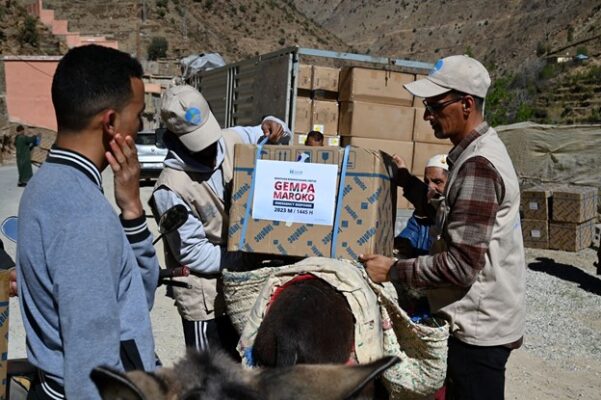By Kaitlyn Waring
The Current Reality of Humanitarian Aid
Humanitarian aid in recent years, despite its basis in principles of morality and helping those in need, has increasingly tailored to political agendas rather than providing impartial international relief efforts to alleviate global suffering. The result is a humanitarian response that often falls short of what the most vulnerable people across the globe require, especially in the urgent aftermaths of natural disasters.
As the impacts of climate change accelerate and outpace mitigation efforts, natural disasters are becoming more frequent and severe, disproportionately targeting large groups of vulnerable people. Natural disasters have proven to have an outsized impact on already-vulnerable populations due to a number of economic, social, and environmental factors and will continue to ravage these groups, giving them increasingly less time and resources to bounce back from devastation.
These same groups of people are most often not the ones responsible for the vast majority of CO2 emissions and other climate change catalysts, yet they consistently fall victim to its impacts on a large scale. Lack of resources and infrastructure in communities results not only in less protection against natural disasters meaning greater loss of life and destruction of land and infrastructure, but also in less of an ability to recover and rebuild the critical infrastructure that is needed to move forward in everyday life.
Humanitarian aid in an international setting is intended to address this disconnect and provide these vulnerable communities with outside resources for disaster risk reduction as well as disaster recovery. Yet, despite the larger goal of humanitarian aid, its real-time implementation has faced many challenges, leaving some of the most in-need people unaccounted for and struggling. All too often, the ones left behind are those in lesser developed countries who have contributed little to the very climate phenomena that are impacting them.
Gaps in Funding and Awareness
One reason for the ineffectiveness and inefficiency that often comes from humanitarian aid across certain regions of the world is the large gap between the needs of the people and the funding that is available and provided by donor countries. This has resulted in just a handful of crises receiving a majority of funding and attention from international actors. In recent years, nearly half of humanitarian funding has been directed towards causes in Ukraine, Syria, Yemen, Afghanistan, and Palestine. While the humanitarian and environmental crises in these countries certainly necessitate high levels of relief and aid, insufficient levels of overall funding have left other critical countries such as Sudan, Burkina Faso, and the Democratic Republic of the Congo neglected.
Not only are these places not receiving adequate humanitarian funding, they also do not receive the high levels of international attention and news that could encourage greater aid. One study by CARE International found that in 2023, the top ten most under-reported humanitarian and environmental crises in the world are in Africa. From hunger, to conflict, to natural disaster and climate change impacts, millions of people are in need of the relief that proper levels and types of humanitarian aid can provide, yet they are not receiving widespread attention in news and media.
One example given highlights how the 2023 Barbie movie was applauded in over 273,000 articles across the world for its messages on women’s rights and empowerment while the abuse of these same rights in multiple countries across the African continent have gone unreported. Similarly, in Angola, for example, there are around 7.3 million people in need of humanitarian aid, but this crisis only received 1,049 media mentions in 2023. Compared to the 273,421 articles written alone about the newly released iPhone 15, these numbers are significantly lacking.
Politics of Humanitarian Aid
The lack of funding of the humanitarian needs and natural disasters of certain regions of the world is also often a symptom of geopolitical prioritizations. Certain countries, even while receiving higher amounts of media coverage, are also often deprioritized compared to areas of greater geographic and political significance for donor countries.
Some discussions surrounding humanitarian aid suggest that disaster relief favors high-profile emergencies at the expense of others suffering farther from the political spotlight. Because just 11 countries provide around 90% of humanitarian aid, countries that have historical ties, that lie geographically closer, or that are more important from a foreign policy perspective to this group of donors may receive greater attention.
In one instance, it was found that donor-recipient distance reduces funds to African disasters by 21% compared to disasters in Europe. Therefore, countries in regions such as Eastern Europe, the Middle East, North Africa, and Caribbean islands are in geographically more ideal locations for many North American and European donors compared to those in Sub-Saharan Africa, the South Pacific, and South America.
Infrastructure Challenges
When countries are less ideally located, politically strategic, or media-grabbing, their humanitarian aid appeal can suffer. They may also suffer from a lack of necessary infrastructure that makes humanitarian aid and disaster relief optimal, delaying aid or reducing its effectiveness, particularly in rural and remote regions. Ensuring access to relief resources can be extremely difficult where there is a lack of infrastructure.
Isolation can result from a number of factors. The physical environment of a country or region, such as a mountainous region, remote island, or remote indigenous community, creates physical barriers to humanitarian aid implementation. Additionally, the presence of conflict and insecurity in a region will largely decrease the appeal of aid and the ability to carry out relief operations. In a similar way, political and administrative practices of countries can also put restrictions on the operations, or even acceptance, of humanitarian aid. All of these factors may discourage large scale humanitarian relief efforts due to higher costs and less ease of implementation and effectiveness. Unfortunately for regions in Africa that experience one or more of these physical barriers, instability in government, or conflict, natural disaster impacts are exacerbated by the lack of responsive, effective relief capacity.
Additionally, while most African governments have already embraced the importance of disaster risk reduction, many have not yet integrated this concept into the actual laws and policies that govern in disaster situations. In the absence of these frameworks for preparation and response, the networks of community organizations and NGOs that operate in Africa have less resources to successfully respond and are more likely to lack coordination. In general, the existing laws in many African countries give little emphasis to the engagement and empowerment of communities themselves to strengthen the local resiliency that results in more effective disaster recovery.
What Does the Future Look Like?
Going forward across all international climate agreements, the consideration for greater and more responsive humanitarian aid in the wake of natural disasters will be critical for supporting the local communities of vulnerable people around the world. International climate talks have already introduced the concept of a loss and damage fund to support communities who are experiencing or will experience effects of climate change that are unavoidable and irreversible. This type of aid, along with a strengthening of disaster risk reduction and response systems globally, are required in order to ensure that adequate humanitarian funds exist and are directed towards all of the regions of the world that need them, without leaving anyone behind to deal with disasters alone.
A critical deciding factor in the success of relief efforts is their basis in local decision making and community empowerment. Top-down approaches will often result in a failure of recovery progress if they don’t address the top priorities of those impacted by disasters. As people tend to know what is in their own best interest, humanitarian aid can then act as a way to facilitate these recovery goals and ensure a long-lasting and resilient community rebuilding process.
Kaitlyn Waring is currently a student at Northeastern University in Boston, USA, and she volunteered with the High Atlas Foundation in Morocco from July to December of 2024.









